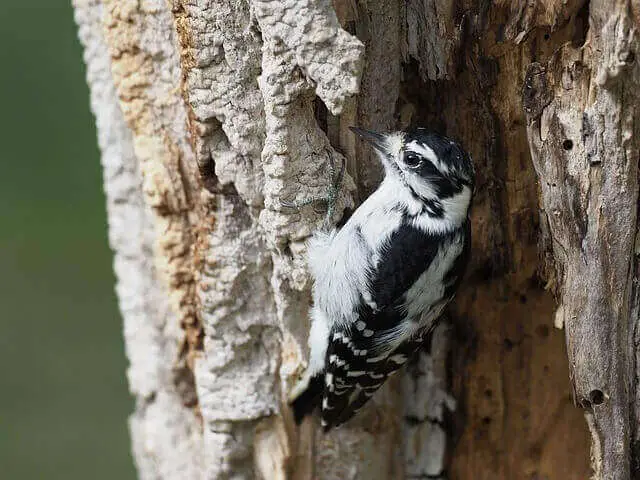Quebec’s diverse landscapes, ranging from boreal forests to coastal regions, provide a rich habitat for a wide variety of bird species. In this comprehensive guide, we’ll introduce you to the 62 most common birds you can find in Quebec.
We’ll dive into their unique habitats, behaviors, and prime spotting locations across the province, making it the ultimate resource for birdwatching enthusiasts.
Table of Contents
- 1 Most Common Birds in Quebec
- 1.1 American Crow
- 1.2 Black-capped Chickadee
- 1.3 American Robin
- 1.4 American Goldfinch
- 1.5 Song Sparrow
- 1.6 Blue Jay
- 1.7 European Starling
- 1.8 Downy Woodpecker
- 1.9 Red-winged Blackbird
- 1.10 Mourning Dove
- 1.11 Common Grackle
- 1.12 White-throated Sparrow
- 1.13 Common Raven
- 1.14 Dark-eyed Junco
- 1.15 Hairy Woodpecker
- 1.16 White-breasted Nuthatch
- 1.17 Rock Pigeon
- 1.18 Northern Flicker
- 1.19 Northern Cardinal
- 1.20 Chipping Sparrow
- 2 Frequently Asked Questions
- 3 Author
Most Common Birds in Quebec
American Crow
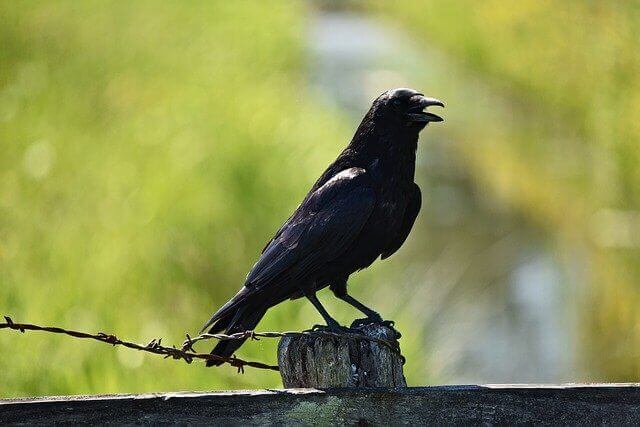
The American crow is a medium-sized passerine birds of the genus Corvidae living mostly in mountainous areas of North America. It is an ubiquitous bird, found across much of North America from the Great Plains to the Rockies.
One of their most noticeable characteristics is their annual migration southward in wintertime, when they fly south along the coast and into the southern latitudes of North America. A migrating crows’ primary food source is berries, seeds, insects, and even plants during this period.
- Frequency: 56.31% (Statistic: eBird)
- Color: Black
- Habitat: Open country, farms, parks, woodlands, towns, cities
- Range: Canada, USA, Mexico
- Size: 16 – 21″ inches
- Weight: 315 -620 grams
- Diet: invertebrates, carrion, seeds, eggs fish, grains, mice, frogs, and other small animals.
- Family: Corvidae
- Genus: Corvis
Related: How To Attract Crows To Your Backyard: Expert Tips!
Black-capped Chickadee
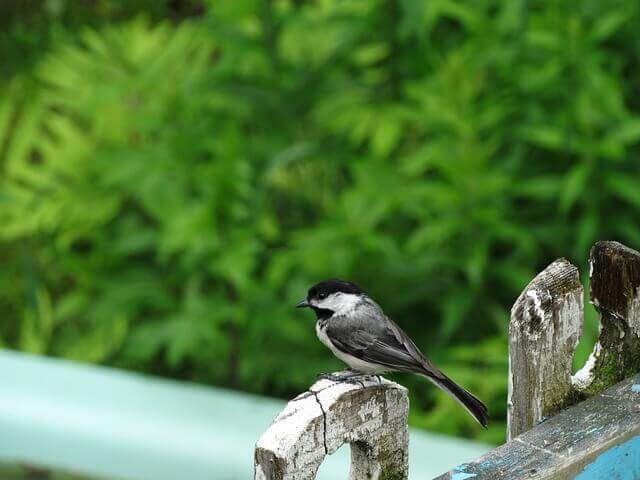
The black-capped chickadee, is a small migratory, North American bird with a short wingspan and medium body size. It’s the state bird of Massachusetts, Maine, and Canada in the U.S., and the national, provincial bird of New Brunswick in Canada, and it is also the most popular bird among backyard birdwatchers in southern Maryland and Virginia.
Like many North American birds, black-capped chickadees are seldom seen in abandoned beech trees, along riverbanks, in crop fields and swamps, and in some forests. They are especially common at dawn and dusk, during which time they are highly active.
- Frequency: 53.76%
- Color: Black-cap, white on face, white/reddish-brown flanks
- Habitat: Deciduous and mixed forests, backyards, parks
- Range: USA and Canada
- Size: 11.5 -16 cm length
- Weight: 8 – 15 grams
- Diet: Insects, seeds, berries
- Family: Paridae
- Genus: Poecile
Related
American Robin
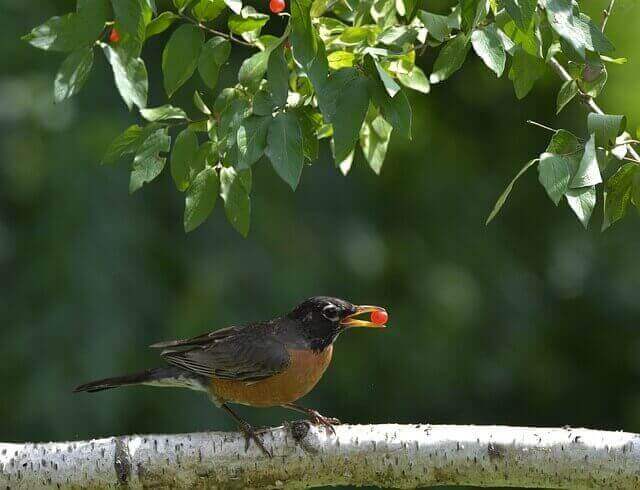
The American Robin is a beautiful, popular songbird with a long, rangy flight and a beautiful bill. The American robin is part of the wintering birds’ family Turdidae and migratory songbirds of the greater eastern plain.
They feed on a variety of foods, including seeds, berries, and nectar, but prefer sunflower seeds and walnuts. They can be found from southern Canada and the northern Rocky Mountains all the way south to Mexico.
- Frequency: 40.21%
- Color: Mostly brown on the back with an orange colored breast
- Habitat: Wooded areas, backyards, parks, fields
- Range: USA, Canada, Mexico
- Size: 12 – 16″ inches
- Weight: 72 – 95 grams
- Diet: Fruits, berries and insects (earthworms, beetles, caterpillars
- Family: Turdidae
- Genus: Turdus
Related:
- Interesting American Robin Fun Facts
- How To Attract Robins To Your Yard – 7 Best Tips!
- 5 Best Bird Feeders For Robins (Tested & Rated For 2022)
American Goldfinch
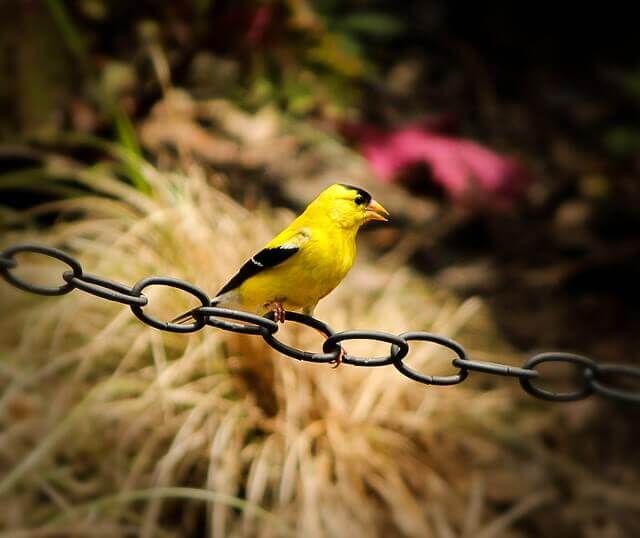
The American goldfinches is a rather common little North American bird, in the finch familial, Spinus genus. Mating season is usually in the late summer or early fall in the United States and Canada, although it’s not uncommon for a pair to wait until the spring before breeding.
While not quite as colorful as its more commonly known cousin, the oriole, the American goldfinch have a pretty bright yellowish throat and upper breast, black wings and forehead with white markings. You can see them along fields, meadows, open country, backyards, roadsieds and orchards.
- Frequency: 38.20%
- Color: Face, neck, and underside are yellow, black wings with white bars
- Habitat: Deciduous forests and thickets, roadside, grasslands, backyards, meadows
- Range: Canada, USA and Mexico
- Size: 4.3 – 5.5″ inches length
- Weight: 12 -18 grams
- Diet: Grass, dandelions, chickweed, sunflowers and ragweed, thistle, red alder, birch, spruce seeds
- Family: Carduelinae
- Genus: Spinus
Related: American Goldfinch Interesting Facts
Song Sparrow
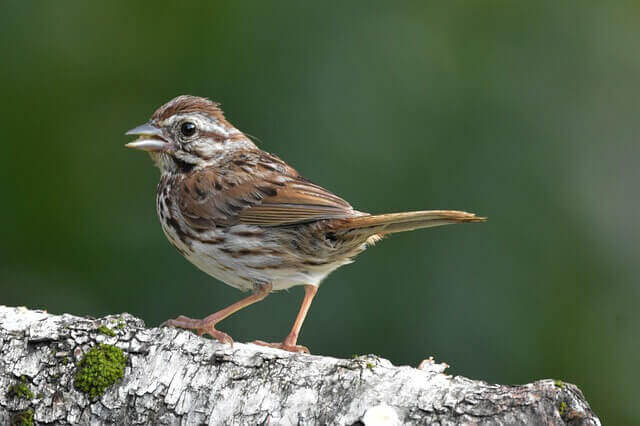
The song sparrow, also known as the American sparrow, is a small common ground-dwelling bird found in all parts of North America. As the only songbird among the migratory shorebirds, it spends most of its time on the ground, particularly foraging for food, and it is also adept at dancing while perched on exposed branches or twigs.
In fact, it has even been recorded dancing while walking across the beach at sunset. Because it feeds on almost anything edible, this small songbird makes a good companion for nature lovers and urban wildlife enthusiasts alike.
- Frequency: 35.44%
- Color: Gray head, white cheek, a black bib, rufous neck
- Habitat: Urban centers, farms, backyards, edges, yards, and parks
- Range: Europe, Mediterranean, Asia, Australasia, Africa, and the Americas
- Size: 5.5 – 7.0″ inches
- Weight: 25 – 40 grams
- Diet: Grains, seeds, and insects
- Family: Passeridea
- Genus: Passer
Related: How to Attract Sparrows to your Backyard
Blue Jay

The blue jay, is an extremely common passerine bird among the sociable species of urban birds in the suburbs of North America. The best time to see the blue jay is from late spring through early summer, because they exit from the eastern coastline in the spring and return to the same spot in July for nesting. You can usually find them on wooded areas, shoreline cliffs or near piers.
These birds are common in marshes, coves and islands, so look for them nesting near these locations as well. They are frequent visitors to park gardens, backyards, lawns, playgrounds, and inner-city backyards where they feed on small seeds, spiders, and beetles.
- Frequency: 33.24%
- Color: Blue crest on the head, wings, back, and tail, and has a white face and belly
- Habitat: Deciduous and mixed forests, mixed woodlands, backyards, parks
- Range: Southern Canada, Eastern and Central United States, Florida and Texas
- Size: 8 – 12″ inches
- Weight: 70 – 100 grams
- Diet: Nuts, seeds, caterpillars, grasshoppers, and beetles
- Family: Corvidae
- Genus: Cyanocitta
Related:
- How to Attract Blue Jays to your Yard?
- 15 Best Bird Feeders For Blue Jays (Tried & Tested 2022)
- Do Blue Jays Migrate? The Truth
- What do Blue Jay Eat – All The Facts
European Starling
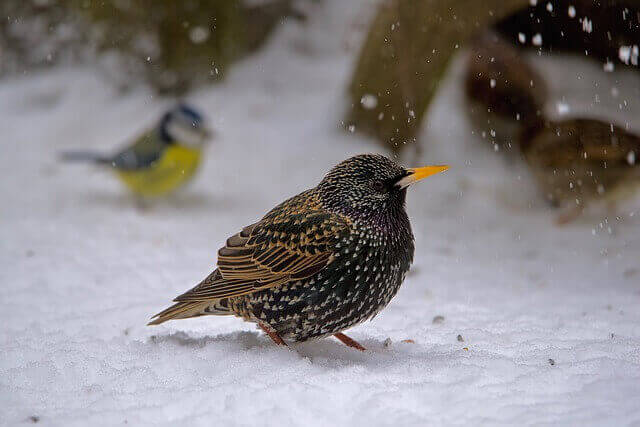
The European starling is a medium-sized passerine bird native to the British Isles. It is around 20 inches long, with a thin yellowish gray plumage with an almost metallic sheen, and has blackish red streaked wings at the rear.
Many of these birds are present in urban areas, where they feed on a wide variety of foods, including carrion, seeds, and even fruit and nuts. The starlings may also take food back to the urban areas to be consumed, although this is not likely to occur in densely forested areas.
- Frequency: 32.57%
- Color: Black with glossy iridescence plumage
- Habitat: Forests, woodlands, backyards, edges, yards, and parks
- Range: North America, Europe, Africa, India, Middle East, China
- Size: 7 – 9″ inches long
- Weight: 60 – 100 grams
- Diet: Insects (ants, beetles, invertebrates), fruits, seeds, berries
- Family: Sturnidae
- Genus: Sturnus
Related: How To Attract European Starlings To Your Yard Fast?
Downy Woodpecker
The Downy Woodpecker is a small species of woodpecker, the smallest in North America. They are generally dark-colored; though some have been spotted with bright red underparts. They have short wings and a thick beak for their eating and chewing food. The bills are short and rounded, helping them to suck insect and insectivore prey.
The Downy Woodpecker lives primarily in southern states in the U.S. and Canada and is rarely seen in the northern parts of its range. Though they do prefer trees in the southern U.S., they will feed on any tree including fruit trees, acorns, and even maple trees.
- Frequency: 27.80%
- Color: Black with a white throat, belly, and back. White spots on wings
- Habitat: Deciduous forests and thickets, roadside, grasslands, backyards, parks
- Range: Canada, USA, and Mexico
- Size: 5.5 – 7.1″ inches in length
- Weight: 20 – 33 grams
- Diet: Mostly insects and beetles and ants, also gall wasps, caterpillars
- Family: Picadae
- Genus: Dryobates
Related: How to Attract Downy Woodpeckers to Your Yard? (Easy!)
Red-winged Blackbird
The red-winged blackbird, is a passerine bird of the genus Icterides that occur in the forested lakes, streams, and slow rivers of southwestern North America, from the Rocky Mountains to the southern United States and south through Mexico to South America, among other places.
It has a varied diet including insects, seeds, weeds, waste, and small animals. They are almost exclusively found in the marsh areas of eastern North America
- Frequency: 26.35%
- Color: All black with red patches on shoulder and a yellow wing bar
- Habitat: Deciduous forests, conifers, roadside, rivers, backyards, parks
- Range: North America, Central America
- Size: 6.7 – 7.1″ inches length
- Weight: 41.5 – 65 grams
- Diet: Seeds and insects (butterflies, dragonflies, moths, frogs, worms, spider, snails, carrion, flies.)
- Family: Icteridae
- Genus: Agelaius
Mourning Dove
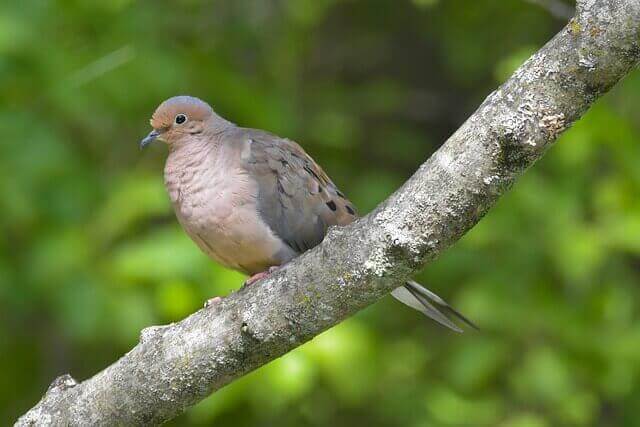
The Mourning Dove is a delicate member of this dove familial, Columbidae. The species has historically has been called the turtle Dove. It is probably the most common and widespread of North American birds, with over ten million pairs living in the wild.
During the spring and summer months the male mourning dove will head to the trees in search of food and mates, but in the winter they migrate to shelters such as lodgepole pines, oak trees, hemlocks, and conifers. They eat many different kinds of seeds, small insects, berries, mites, spiders, carrion, etc.
- Frequency: 25.52%
- Color: Light gray-brown and lighter and pinkish below. The wings have black spots.
- Habitat: Open habitats, urban areas, farms, prairie, grassland, wooded area
- Range: USA, Canada, Mexico, Central America, Greater Antilles
- Size: 12″ inches length
- Weight: 112 – 170 grams
- Diet: Rapeseed, corn, millet, safflower, sunflower seeds, pokeberry, sesame, and wheat.
- Family: Columbidae
- Genus: Zenaida
Related:
- Facts About Mourning Doves – 10 Things You Need To Know!
- Best Bird Feeder For Doves (Reviewed & Tested for 2022)
Common Grackle
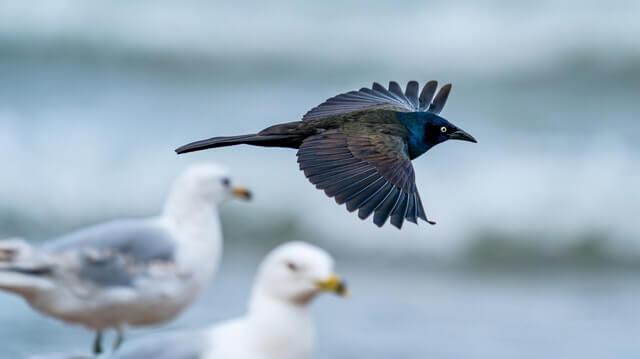
The common grackle is a common wintergreen found in millions throughout much of North America. First identified in 1758 by German naturalist, Carl Linnaeus, the common grackle has since then been described in numerous species.
They prefer wooded areas with plenty of cover along with other small birds. They prefer to build nests in abandoned logs or trees that have previously rotted out. Hatching eggs in late spring or early summer is common with these species, as is building and feeding of nestlings. Both types of birds prefer to nest near food and water sources.
- Frequency: 25.25%
- Color: Black overall with a blue, and purple iridescence. Its body plumage is a shimmering copper color.
- Habitat: Woodlands, marshes, meadows, parks, backyards, and fields
- Range: East of the Canadian Rockies, Canada and the United States
- Size: 11 – 13″ inches length
- Weight: 75 – 143 grams
- Diet: minnows, eggs, berries, seeds, grain, insects, frogs, mice
- Family: Icteridae
- Genus: Quiscalus
White-throated Sparrow
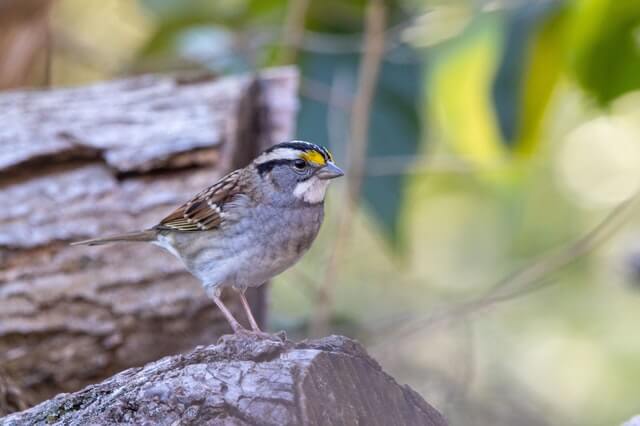
White-throated sparrow are known for their long flights and for their acrobatics. In captivity, they usually breed on different types of habitat, but almost always on a tree trunk or on a ledge.
Since the white-throated sparrows are so accustomed to living high up, they can be found on fences, ledges, and even rooftops in most places where they prefer to live. Because of their extreme flight abilities, they often find their food on the ground near nesting areas and their nesting boxes.
- Frequency: 22.94%
- Color: Brown and gray head pattern. Black-and-white-striped head, white throat, and some yellow near both eyes.
- Habitat: Deciduous forests and thickets, roadside, grasslands, backyards
- Range: Eastern North America, Atlantic Canada
- Size: 5.9″ – 7.5″ inches long
- Weight: 22 – 32 grams
- Diet: Seeds, insects, and berries
- Family: Passerellidae
- Genus: Zonotrichia
Common Raven
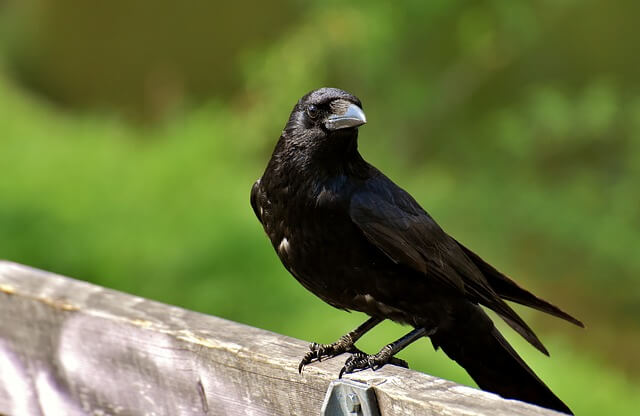
Found throughout the Northern Hemisphere, it’s the fourth-most widespread of all passerines. Most of the time, the common ravens can be found in wooded areas along river banks or swamps. They are excellent-perching birds. Their powerful beaks enable them to grab small prey such as frogs, moles, and shrews. In the spring they are found flying along trees, feeeding on berries.
The lives of these birds vary depending on the time of year. In the late spring and early summer they gather near trails and roads to feed. They are also said to return to their nests in the fall and in some areas they mate in the wintertime, with the female bird staying with the male through the year.
- Frequency: 21.11%
- Color: All black iridescent plumage
- Habitat: Wooded areas, evergreen forests, tundra, roadside, grasslands, backyards, parks
- Range: Found throughout the Northern Hemisphere
- Size: 21 – 26 inches long
- Weight: 1.5 – 4.5 lbs.
- Diet: Mainly scavengers, feeding on carrion, beetles, and maggots.
- Family: Corvidae
- Genus: Corvus
Related: 18 Fun Facts About Ravens That Will Amaze You
Dark-eyed Junco
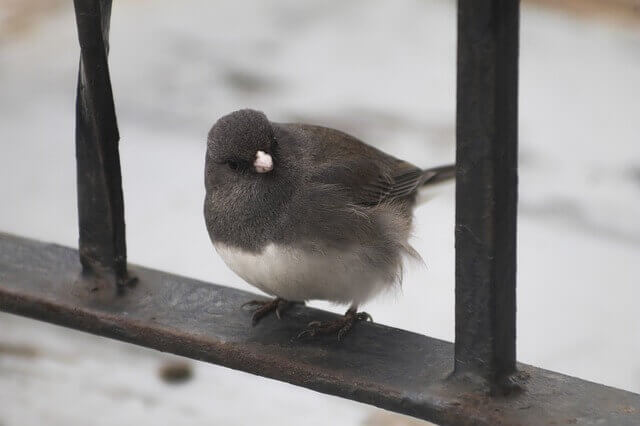
The Dark-eyed Junco (Junco hyemalis) is a small sparrow with a slate-colored back and white belly. They are found in North America from Alaska to Newfoundland, and south to California, Arizona, and New Mexico. Dark-eyed Juncos are year-round residents of forests, woodlands, and brushy areas.
They typically build their nests in trees or shrubs, but will also nest on the ground if necessary. The diet of the Dark-eyed Junco consists primarily of seeds and insects. In winter, juncos will often visit bird feeders in search of sunflower seeds or other high-energy foods.
- Frequency: 21.09%
- Color: Gray head, neck, breast, gray/brown backs and wings, white underside
- Habitat: Wooded areas, forest edges, roadsides, gardens, parks.
- Range: USA and Canada
- Size: 5.1 – 6.9″ inches
- Weight: 18 – 30 grams
- Diet: Seeds, insects, and arthropods
- Family: Passeriformes
- Genus: Junco
Related: Fun Facts About Dark-eyed Juncos
Hairy Woodpecker
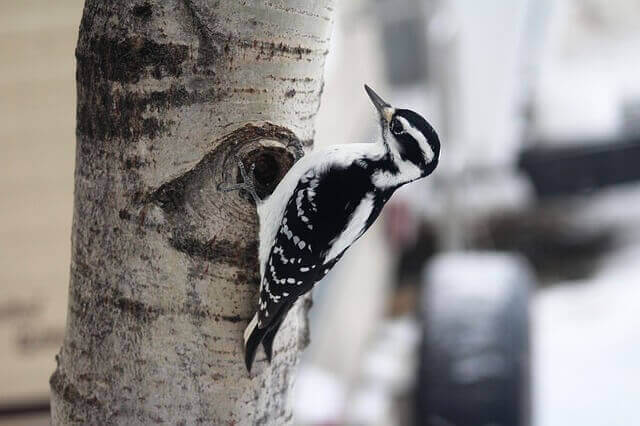
The hairy woodpecker, a medium-sized woodpeckers is found throughout much of North America. It is about 250mm in length with an approximately 380mm wingspan. This bird has a variety of physical characteristics and life patterns which distinguish it from other woodpeckers. It is generally nocturnal, spends most of its waking hours in the air, but does travel some distance in the daylight to forage for food.
The typical habitat of this bird consists of shrubs, trees, brush, and open meadows or fields. It has also been known to utilize small shrubs and trees for nesting, and cavity nooks in houses, attics, decks, and gazebos. Hairy woodpeckers are great drill pilot holeschers, building nests in tree branches and inside birdhouses.
- Frequency: 20.85%
- Color: Black and white checkered throughout, all white underside, has a mask
- Habitat: Wooded areas, forest edges, roadsides, gardens, parks.
- Range: USA and Canada
- Size: 7.0 – 10″ inches in length
- Weight: 40 – 95 grams
- Diet: Berries, seeds, nuts beetles, ants, caterpillars, and others.
- Family: Tyrannidae
- Genus: Tyrannus
White-breasted Nuthatch
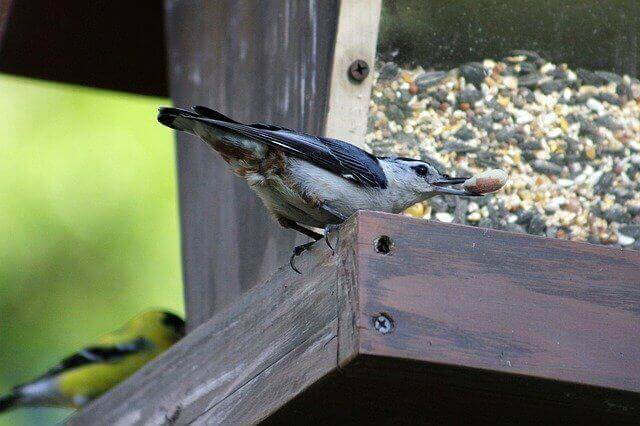
The white-breasted nuthatch has been a popular songbird throughout Quebec each migratory season. In July and August, white-breasted nuthatches are frequently seen in large flocks on tree trunks in the eastern U.S. and Canada.
While not a common visitor to bird feeders, this type is well worth considering if you have a bird feeder you would like to attract this species. It would be a wonderful addition to your nectar feeder collection.
- Frequency: 18.29%
- Color: Has a white face, flanks, and chest. It has a black cap on its head a bluish-gray upper and a brown belly
- Habitat: Deciduous forests, conifers, roadside, rivers, backyards, parks
- Range: Southern Canada, USA
- Size: 5.9″ inches
- Weight: 20 grams
- Diet: Acorn nuts, hickory nuts, ants, caterpillars, scale insects, pine weevils
- Family: Sittidae
- Genus: Sitta
Related: How to Attract Nuthatches to your Backyard
Rock Pigeon
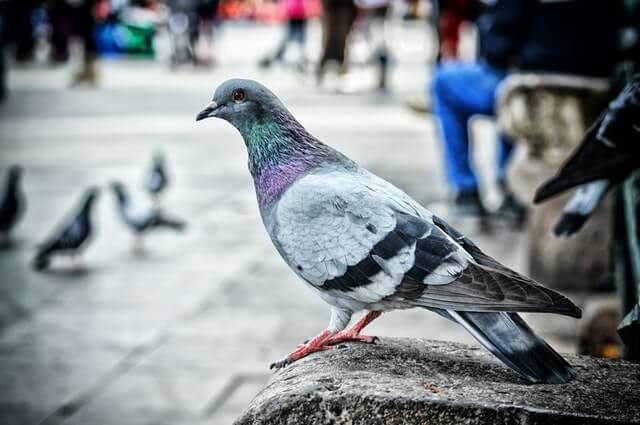
The rock pigeon, the common pigeon, or rock dove is part of the genus Columbidae, a familial of pigeons Rock Pigeons are commonly found in a variety of habitats throughout North America. They are most abundant in sagebrush woodland, rocky areas, swamps, and along coastal areas. The preferred food is berries, suet, seeds, insects, and carrion.
Rock pigeons are fairly recent birds, having originated around the late 1600s from the coasts of Spain and Portugal. They can be found on nesting objects such as logs, dead trees, trash, and poles and they return to the same place each year.
- Frequency: 17.31%
- Color: Dark blue-gray head, neck, and chest with a yellow, green and red iridescence on its neck and wings.
- Habitat: Woodlands, marshes, meadows, parks, backyards, and fields
- Range: Europe, North Africa, South Asia, Canada and USA
- Size: 11 – 15″ inches long
- Weight: 235 – 380 grams
- Diet: They areomnivorous, but also like seeds, plant matter, sugary fruits and grains.
- Family: Columbidae
- Genus: Columba
Related: Birds that look like Pigeons (Photos, ID & Stats)
Northern Flicker
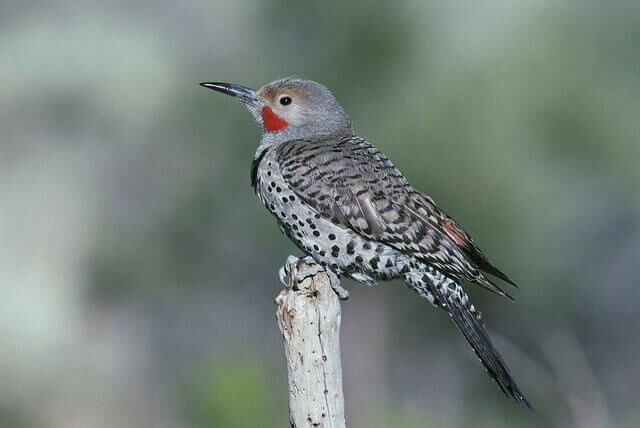
The Northern Flicker is a mid-sized woodpecker. It is extremely widespread in many parts of North America, especially parts of central America, Cuba, and even the Cayman Islands, and has been one of the very few woodpecker species which remains on its own for the majority of its life.
Unlike most other woodpeckers, the male Northern Flicker makes and plays a varied variety of song types including but not limited to a high-pitched squawking, a high-pitched chirping, a low-pitched wail, and a series of high-pitched chirps. Their diet consists of ants, mites, spiders, termites, bees, wasps and wasp eggs, and eventually even livestock.
- Frequency: 16.86%
- Color: Light brown with black bars across back, chest, wings, belly
- Habitat: Forests, woodlands, backyards, edges, yards, and parks
- Range: North America, Central America, Cuba, Cayman Islands
- Size: 10 – 14″ inches
- Weight: 85 – 165 grams
- Diet: Insects (ants, beetles, invertebrates), fruits, seeds, berries
- Family: Picadae
- Genus: Colaptes
Related: How to Attract Northern Flickers to your Backyard? (Easy)
Northern Cardinal
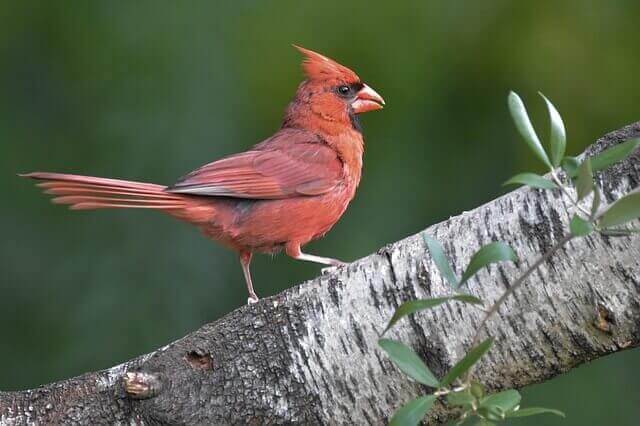
The Northern Cardinal is a beautiful bird that is common across much of North America, except for the extreme southern parts, where it is considered an invasive species. It’s also found in southern Canada, east of the US through the central to southwestern US, south to northern Mexico, Guatemala, and Belize, south to northern Mexico, Central America, west to the mountains of Peru, and to northern Argentina.
The primary food source for the birds is seeds and larvae of berries and thistle. They also eat other types of vegetation, such as grasses, weeds, nasturtiums, and algae. In winter, northern cardinals are mostly idle or less active, using their body weight and slow movements to hang from twig ends, leaf piles, or any low surface they can find.
- Frequency: 16.32%
- Color: Mostly red with a black mask on the face, short pink bill
- Habitat: woodlands, gardens, parks, backyards, and wetlands
- Range: USA, Canada, Mexico
- Size: 8.2 – 9.3″ inches
- Weight: 33 – 65 grams
- Diet: Fruits, berries, and insects (grasshoppers, beetles, snails, cicadas)
- Family: Cardinalidae
- Genus: Cardinalis
Related:
- 10 Best Bird Feeders for Cardinals (Rated for 2022)
- Best Birdhouse for Cardinals 2022 (Tested And Rated)
- Where are Cardinal Birds Found – Best Places to Look
- Cardinal Bird Facts You Never Knew
Chipping Sparrow
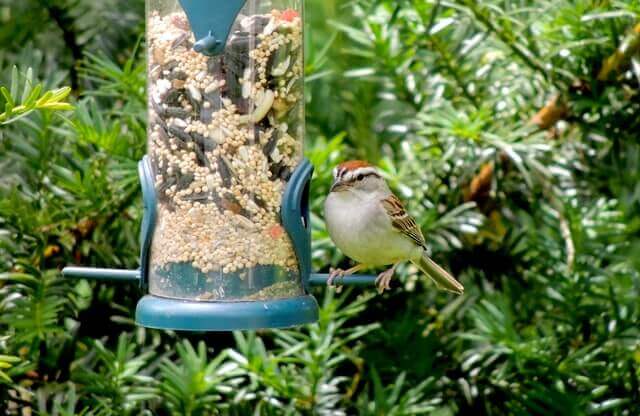
The chipping sparrow is inconspicuous species of New World avian, a member of the Passerellidae familial. It is widespread, quite docile, and quite common throughout most of its North American continent range. It is small, about 4.7″ – 5.9″ long, with gray below and an orangish-rust color above, a stout, narrow beak, and sharp claws.
The chipping sparrows are generally found throughout north America, but they are particularly common throughout the southern states, particularly around the southern border of Texas into southern Louisiana. They are most active at night, with their flight periods occurring in the late evening and early morning. During this time, they forage in fields, meadows, swamps, and forests.
- Frequency: 15.50%
- Color: Rust-colored upper-parts, gray head, and underparts with a reddish cap on the head
- Habitat: Coniferous forests, woodland, farmland, parks, and gardens
- Range: Southern USA and Mexico
- Size: 4.7 – 5.9″ inches
- Weight: 11 – 16 grams
- Diet: Mostly seeds, spiders
- Family: Passerellidae
- Genus: Spizella
Related: How to Attract Sparrows to your Backyard
The backyard birds below have a frequency of less than 15.5% year-round
- House Sparrow 15.38% Frequency
- Red-breasted Nuthatch 15.08%
- Tree Swallow 14.30%
- Yellow-rumped Warbler 13.53%
- Purple Finch 12.98%
- Cedar Waxwing 12.95%
- Red-eyed Vireo 11.97%
- Common Yellow throat 11.09%
- Ruby-crowned Kinglet 10.22%
- Yellow Warbler 9.85%
- American Redstart 9.16%
- Pine Siskin 9.14%
- Killdeer 8.49%
- Common Redpoll 7.81%
- Evening Grosbeak 7.75%
- American Tree Sparrow 7.67%
- Savannah Sparrow 7.54%
- Belted Kingfisher 7.49%
- Gray Catbird 7.15%
- House Finch 7.03%
- Green-winged Teal 7.02%
- Hermit Thrush 6.80%
- Swamp Sparrow 6.74%
- Brown-headed Cowbird 6.72%
- Yellow-bellied Sapsucker 6.62%
- Veery 6.61%
- Golden-crowned Kinglet 6.48%
- Magnolia Warbler 6.45%
- Spotted Sandpiper 6.44%
- Pileated Woodpecker 6.29%
- Ruby-throated Hummingbird 6.29%
- Barn Swallow 6.03%
- Ovenbird 5.95%
- Eastern Phoebe 5.89%
- Common Eider 5.67%
- Nashville Warbler 5.52%
- White-crowned Sparrow 5.46%
- Black-throated Green Warbler 5.39%
- Chestnut-sided Warbler 5.26%
- Eastern Kingbird 5.20%
- Winter Wren 5.18%
- Brown Creeper 5.03%
Frequently Asked Questions
What is the bird of Quebec?
In 1987, the Legislative Assembly of Quebec chose the snowy owl (Nyctea scandiaca) as Quebec’s official bird. The snowy owl is a large, white owl with yellow eyes. It is found in North America, Europe, and Asia’s Arctic regions. The snowy owl is a protected species in Canada.
What is the most common bird in Montreal?
The black-capped chickadee is the most common bird in Montreal, with a frequency of occurrence of 63.27 percent. The next most common bird is the Northern Cardinal, with a frequency of occurrence of 60.61 percent. The third most common bird is the American Crow, with a frequency of occurrence of 59.38 percent.
Are there finches in Montreal?
Yes, there are finches in Montreal! There are seven different species of finches that have been spotted in the city: American Goldfinch, European goldfinch, house finch, Purple Finch, Eurasian Bullfinch, zebra finch, European Greenfinch. While all seven species of finches have been spotted in Montreal, the American Goldfinch is by far the most common.
Are there eagles in Quebec?
There are three species of eagles that can be found in Quebec: the bald eagle, golden eagle, and Steller’s sea-eagle. All three of these species are protected under the Migratory Birds Convention Act. The bald eagle is the largest and most common of the three eagle species found in Quebec.
Are there crows in Quebec?
There are three species of crow found in Quebec: the American Crow, Fish Crow, and Pied Crow. However, the most common crow in Quebec is the American Crow.
Are there owls in Montreal?
Yes, there are owls in Montreal! In fact, there are twelve different species of owls that have been spotted in the city. These include the Eastern Screech-Owl, Great Horned Owl, Barred Owl, Snowy Owl, Long-eared Owl, Short-eared Owl, and Northern Saw-whet Owl, Great Gray Owl, Boreal Owl, Barn Owl, Northern Hawk Owl, and the Burrowing Owl. Eastern Screech-Owls are the most common type of owl in Montreal.


